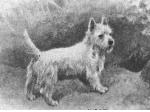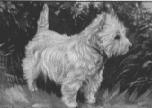 There are many other references and paintings of early westie type dogs. Paintings such as Edwin Lanseers "Dignity and Impudence" which showed a bloodhound and an early highlander.
There are many other references and paintings of early westie type dogs. Paintings such as Edwin Lanseers "Dignity and Impudence" which showed a bloodhound and an early highlander.
We must rely on what has been written previously to decide which is to be believed. In Roger Wrights book on West Highland White Terriers he has two poems. One written by John Whitaker in 1771 and another by Dr Gordon Stables in 1879 both depicted a small, game, hardy terrier with a harsh coat existed as early as the 18th century. In another book it states that white dogs of the Westie type were seen on the ships of the Spanish Armada and that these dogs were on board to catch rats. There are references to white "earth dogs" as far back as 1566 when it was reported that James I requested 6 of them to be sent to the King of France as a gift.
 There are many other references and paintings of early westie type dogs. Paintings such as Edwin Lanseers "Dignity and Impudence" which showed a bloodhound and an early highlander.
There are many other references and paintings of early westie type dogs. Paintings such as Edwin Lanseers "Dignity and Impudence" which showed a bloodhound and an early highlander.
Most breeds are the result of cross breeding and the Westie is no exception. There are also different views as to which breeds were crossed to develop what we know today as the WHWT. The most common being a cross between the Scottish and the Cairn Terrier.
In the mid 1800's white puppies which appeared in litters where thought to be impure, weak and undesirable and as a result were put down. Colonel Malcolm of Poltaloch is said to be one of the earliest breeders of the Westie. This is said to have come about after the accidental shooting of one of his favourite brown terriers while out hunting in the late 19th century. After this hunting accident is it said that he limited his breeding to light or white dogs, which of course took years to eliminate any colour.
He is by no means the only person to be involved in the development of the breed. Dr Flaxman also bred a strain of white Scottish Terriers that were lighter in build than the Scottie. Also the Duke of Argylle from Roseneath produced dogs with soft, white coats. Hence early breed names differed. Poltalloch, Roseneath, Pittenweem and White Scottish Terriers. The Poltalloch Terriers were considered to be the true type because of their round heads and short muzzles.
It is well to remember that the Westie was bred to have specific characteristics to allow him freedom to carry out those chores for which he was bred. The highlands of Scotland were rugged, craggy countryside and short legged terriers were needed for hunting game such as, fox, otter, badger and wildcats. They had to be able to follow their quarry whereever they went. Narrow passes, between rocks and often in total blackness as their game made their lairs in, under and between rocks. If a dogs ribs were too round they would get stuck too easily. Therefore small and flat ribbed was a necessity. He also need to be intelligent in order to outwit the crafty game in short order.
 Once you can picture the speed, stamina, determination and courage required for this work then you have a clear picture of a West Highland White Terrier. As the standard states, "possessed of no small amount of self esteem" and seeing what they were required to do is it any wonder?
Once you can picture the speed, stamina, determination and courage required for this work then you have a clear picture of a West Highland White Terrier. As the standard states, "possessed of no small amount of self esteem" and seeing what they were required to do is it any wonder?
Colonel is also credited with bringing the dog to the attention of the public at early shows. Dog shows began in 1859 and all terriers from Scotland were shown under the one name, Scotch or Scottish Terriers. Somewhere between 1899 and 1900 the "White Scottish Terrier" Club was formed but all breeders of the white terriers were not in agreement about the name. Finally unifying in 1904 to gain recognition of the breed with the Kennel Club and the first show to depict the West Highland White Terrier was the Scottish Kennel club in October 1904. Registration commenced in 1907, this was also the first time that the breed was exhibited at Crufts in their own classes. 1907 was also to see the first West Highland White Terrier Champion, Morven.
The breed continued to thrive and grow with many now famous names such as May Pacey's, Wolvey, Mr H Buckley and his daughter, Scotia and B Lucas's, Highclere just to name a few. Then the war came and by the end the breed had been badly affected. Dog shows ceased in 1916 and breeding prohibited in 1917. During this time due to rationing many dogs had to be destroyed. Mrs May Pacy writes in her book that she had 15 dogs put down in one day rather than see them starve. By the end of the war very few Westies remained and the breeding process had to start all over again. Some people had been able to keep some of their more promising prospects going and it was these few that made up the breeding stock when the war was over.
 Shows restarted in 1920 and Mrs Lucas's Ch Highclere Rhalet was the first of 125 champions made up between 1920 and 1939. Of that 125 champions 32 of them were from the Wolvey Kennel. With the outbreak of WWII food although scarce it was available, shows were again suspended but this time breeding wasn't banned. Many agree that the breed was at its best in the time between the wars.
Shows restarted in 1920 and Mrs Lucas's Ch Highclere Rhalet was the first of 125 champions made up between 1920 and 1939. Of that 125 champions 32 of them were from the Wolvey Kennel. With the outbreak of WWII food although scarce it was available, shows were again suspended but this time breeding wasn't banned. Many agree that the breed was at its best in the time between the wars.
However once again the few stalwarts manage to keep their kennels going and were instrumental in the development of the Westie post war. Names such as, May Pacy (Wolvey), Dr and Mrs Russell (Cruben), Miss Wright (Calluna), Miss Wade (Hookwood), Mr and Mrs Dennis ((Branston), Mrs Allom (Furzefield) and Miss Turnbull (Leal). The first champion made up following WWII was CH Freshney Fiametta belonging to Miss E Wade. She had six champions in a short time and Ch Hookwood Mentor the first to carry the Prefix. Mentor went on to be one of the top sires.
There are so many dogs that had a good deal of influence on our present day westies and not all of the champions. Some that spring to mind and you may recognise are:
Furzefield Piper - Never attained his title after loosing a tooth in a fight.
Ch Hookwood Mentor - Sired 11 champions.
Ch Barrister of Branston - Sired 11 champions.
Int Ch Cruben Dextor - Son of Ch Hookwood Mentor. Exported to America after gaining his title in England and was a sire many champions.
Ch Calluna the Poacher - Successful in the ring and can be found on many of todays pedigrees. Produced a number of champions both in England and in America.
Ch Alpin of Kendrum - Sire of Dianthus Buttons.
Ch Pillerton Peterman - Sired 8 champions in England before he immigrated to America with his breeder where he can be seen on many of todays pedigrees.
Ch Famecheck Hallmark - Sired 10 champions in England before following other top sires to America where he also left made mark.
Ch Sollershot Soloist - Sire of many champions.
Ch Dianthus Buttons - One of the most famous of current times as the first Westie to win the prestigous Crufts in 1976.
Ch Glenalwyne Sonny Boy - Breed record holder with 33 Challenge Certificates up to 1987.
Ch Cedarfell Merry-n-Bright - Sire of Ch Glenalwyne Sonny Boy and many other successful in the show ring.
Ch Domaroy Saracen - Top sire in 1982.
NZ & ENG Ch Domaroy Saraband of Whitebriar - Brother of Ch Domaroy Saracen and sire of many champions both in New Zealand and Australia.
Ch Halfmoon of Olac - Bitch Challenge Certificate record holder with 15.
Ch Olac Moonpilot - Winner of Crufts in 1990. Record 45 Challenge Certificates.
 In The West Highland White Terrier by D Mary Dennis and Catherine Owen is a list of all English champions from 1947 to 1985 plus pedigrees of some of the well known westies. Since the beginning of the westie breed there have been many people who have given so much to the breed. Some names have faded now and new ones have arrived on the scene to stamp their mark in the history books.
In The West Highland White Terrier by D Mary Dennis and Catherine Owen is a list of all English champions from 1947 to 1985 plus pedigrees of some of the well known westies. Since the beginning of the westie breed there have been many people who have given so much to the breed. Some names have faded now and new ones have arrived on the scene to stamp their mark in the history books.
With the public wins of Ch Dianthus Buttons and Ch Olac Moonpilot Westies popularity increased tremendously. Unfortunately, popularity often comes at a price. All westies lovers must take care that we preserve the breed as it is meant to be, to retain the true Westie "type and character" and not let "fashion" take hold.
